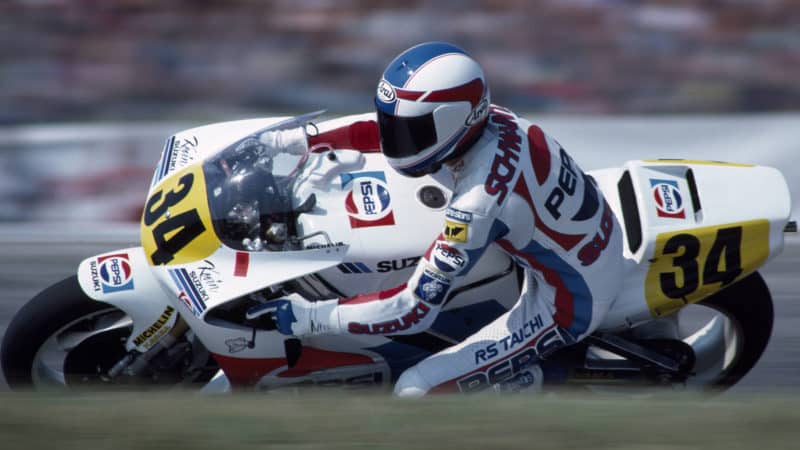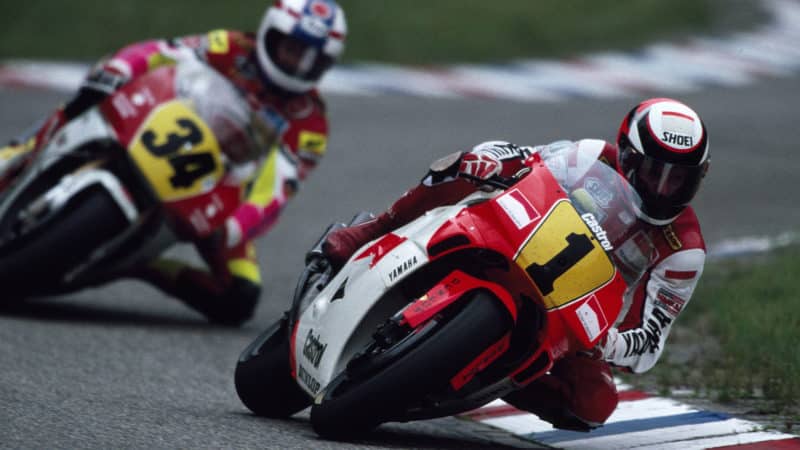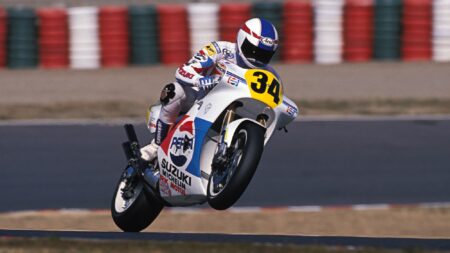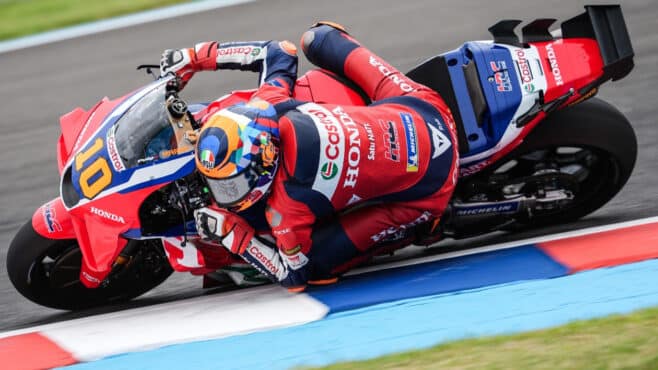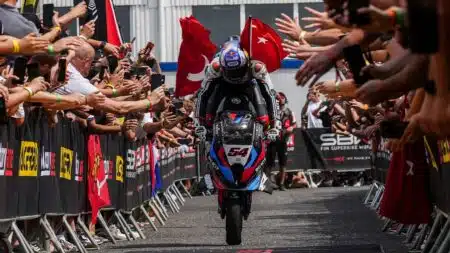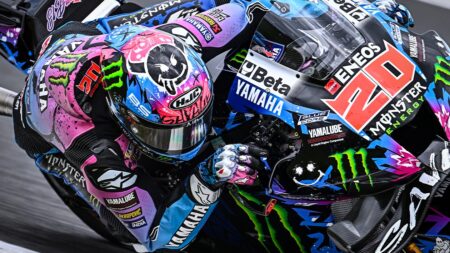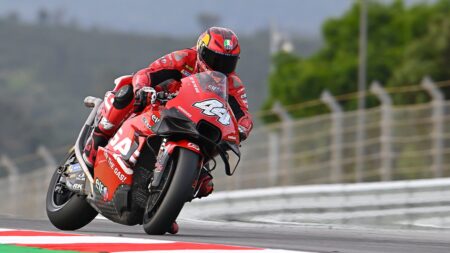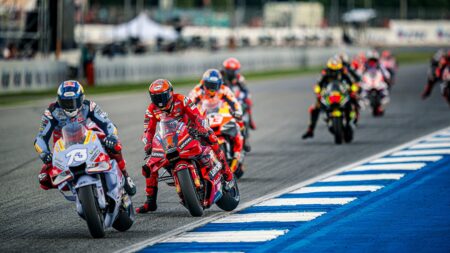Bruno Bonhuil [a Roc Yamaha privateer] almost ran me over and actually spun me around – I was spinning one way and he hit me enough to spin me around the other way!
The main thing I tried to do after a crash like that was to go back and try to figure out what had caused it – did I not get the bike set right before I asked too much of the rear tyre?
I had another big one at Donington, during Friday practice in 1993. I was coming through the left down Craner and the friggin’ thing snapped sideways. They’d put some new gravel beds in there and the edge of the beds must’ve been a foot tall. Anyway, I saved it, ran across grass, thinking, this is fine, then I hit the gravel and went flying.
I got up and Wilf [Needham, Suzuki mechanic] picked me up on a scooter. He asked if I was okay and I said, yeah, I’m fine. Then I’m sitting in the garage struggling to work out which way the track goes – I’ve got no idea! – so I don’t know whether to turn left or right when I ride out the garage on my spare bike.
I’m sat there for 30 minutes and Stu says, you know, you need to do a lap to qualify because it’s supposed to rain all day tomorrow. I said, just point the bike down the pit lane and I’ll be good. Stu knew I was a bit rattled.
I walked out, got on the bike and the third lap I put it third or fourth on the grid. I was lucky there was no concussion protocol back then!
Schwantz and Rainey sweep into turn two at Jerez during the 1993 Spanish GP. Schwantz won by 1.6 seconds
Your greatest pass was probably the last lap at Hockenheim in 1991, when you out-braked Wayne Rainey for the win. Run us through that…
I thought, you know what, I’m gonna be better through that big fast right at the back of the circuit and beat him to the other end of the straight before the last chicane. I go past him and in the chicane I get the bike turned really good, got it spun up in the middle and got it driving out.
Then I’m thinking, if he’s going to come by me on the final straight before the stadium section he’s going to come past me on the right of the track, so I stay stuck to the paint on the right, which is not where you want to be going into the right-hander into the stadium – you want to be over to the left.
“That Marlboro on the back of his seat is getting real big, real quick. I’m thinking, God, I can’t hit him!”
So I start moving to the left and he’s in my draft and comes past me on the right. There’s a crosswalk [bridge] that I used as a brake marker. I remember going under the crosswalk and thinking, holy shit, because when he hits the brakes he’s in way deeper than he’s ever been.
When he came past me there I got in behind him and I hadn’t thought about getting out of his draft. So when he hits the brakes the first thing I have to do is take evasive action because that Marlboro on the back of his seat is getting real big, real quick. I’m thinking, God, I can’t hit him! So I move over and as I move I’m thinking, I’m so far committed that it’s going to be a problem getting stopped for the corner.
I start braking, squeezing as hard as I can, then the bike’s getting out of shape, so I’m on and off with the brake and using a bit of clutch to straighten the bike up. In fact I pull in the clutch in completely and meantime I’m going down through the gears.
But because I’ve got the clutch in I don’t realise I’ve gone back to first gear for a second-gear corner. So when I let the clutch out and get back on the throttle the engine goes bleeugh, because it’s frickin’ 3000rpm over what it needs to be. Oh shit! So I shift back to second and in the video that’s when you see me looking over my shoulder because I figure Wayne’s going to be raging around the outside of me. But I had just a little more into the next left.
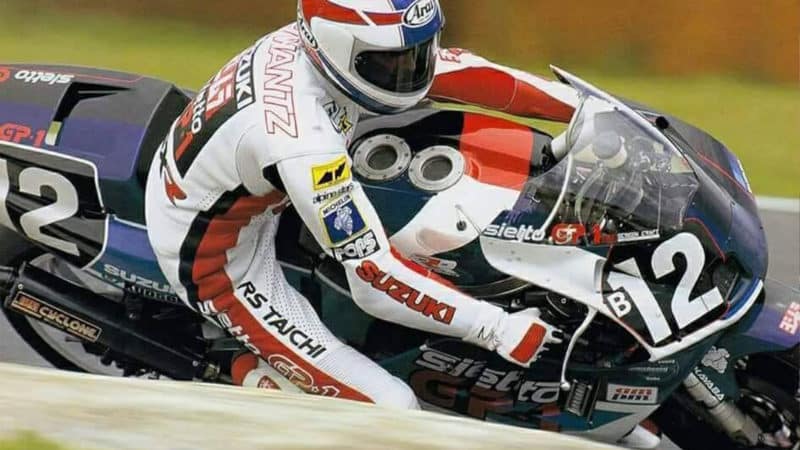
Schwantz aboard a Yoshimura Suzuki GSX-R750 EWC bike during the Suzuka 8 Hours
Suzuki
Another memorable win was at Nürburgring in your 1988 rookie season, when the rain was pissing down, the track was like ice and you beat Rainey and everyone by 25 seconds.
I probably ‘crashed’ a handful of times in that race. I almost crashed on the last lap going into the final chicane – jumped the kerb, into the sand, into the mud and came out the other side. Wow, that was close! My Michelin technician from back then said it was my best race ever, because our rain tyres sucked compared to the Dunlops.
How do you ride a 500 on ice?
What I used to do when I went out for a sighting lap in the rain was grab the clutch and spin the tyre all I could, just to see what the grip was like, to see how slick it was.
You were fired up at Nürburgring because when you won at Suzuka earlier that year Gardner and Eddie Lawson had told you something on the podium…
Yeah, they both said, this won’t happen again! What do you know, five races later it did happen again!
Those were the days when most of the 500 guys did the Suzuka 8 Hours, including you, so how did your riding technique change on a four-stroke?
I don’t think it changed at all. Maybe the physical side of it, because the four-strokes were harder to transition back and forth and so on. But the bikes we raced at Suzuka were usually really good bikes – they handled well and they had decent power. They might not have been quite as fast as the Honda RVF, but Yoshimura always built us pretty good bikes.
The only time the bike wasn’t good was 1992 when the factory did it instead of Yoshimura. Doug [Chandler] and I spent the entire first two or three hours we had on the bike trying to blow it up.
Mick Doohan used to de-clutch all the way into corners with the four-stroke to make the bike feel more like a two-stroke, what about you?
No, I rode exactly the same as I did the 500. Except sometimes the gear-shift pattern. I always used a normal road-shift pattern [one down, five up], whereas most guys shift the other way. So a couple of years at the 8 Hours I tried shifting their way. It was okay, mostly.
One lap in the 1989 race, I think, I’m getting towards the end of the back straight, so I go to shift from fifth to sixth but instead I go from fifth to fourth and blow it up. I get back to the pits and tell the guys that the engine let go but I almost caught it! They pull off the valve cover and all the friggin’ exhaust valves and springs and everything are in bits. They say, that’s an over-rev from a backshift
